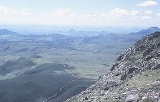
Nyanga National Park
Encyclopedia
Nyanga National Park lies in the north of Zimbabwe
's Eastern Highlands
. One of the first national park
s to be declared in the country, it contains the highest land in Zimbabwe, with green hills and perennial rivers. Most of its terrain consists of rolling downland, sometimes lightly wooded, lying at altitudes between 1,800–2,593 metres (6,560–7,544 feet). Mount Nyangani
, the highest point in Zimbabwe, lies in the centre of the park and Mutarazi Falls
, Zimbabwe
's highest waterfall, is in the south of the park. Nyanga National park incorporates the former Mutarazi Falls National Park on its southern boundary.
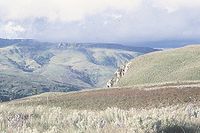 The national park is one of the oldest in Zimbabwe, established as Rhodes Inyanga National Park, a bequest from Cecil Rhodes. The original park borders extended beyond Udu Dam, along the east bank of the Nyangombe River to the north of the current park boundary. This extension was sold in the 1970s, but the Warrendale section, immediately beyond Udu Dam, had been recovered by the early 1980s.
The national park is one of the oldest in Zimbabwe, established as Rhodes Inyanga National Park, a bequest from Cecil Rhodes. The original park borders extended beyond Udu Dam, along the east bank of the Nyangombe River to the north of the current park boundary. This extension was sold in the 1970s, but the Warrendale section, immediately beyond Udu Dam, had been recovered by the early 1980s.
The park nearly doubled in size with the late 1990s purchase of most of the Inyanga Block and Kwaraguza farms. These purchases expanded the national park to the north and east of Mount Nyangani, incorporating some important areas of montane rainforest, the source area of the Kayirezi River and Nyama Falls. The designation and acquisition of Nyazengu farm in 2000, previously an enclave within the park, completed the formal protection of Mount Nyangani and the headwaters of the Pungwe River
, although Nyazengu had previously been operated as a private nature reserve.
The current name Nyanga reflects the correct vernacular pronunciation of the area.
Flora
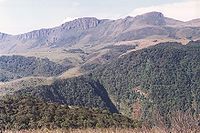 The vegetation of Nyanga is part of the Eastern Zimbabwe montane forest-grassland mosaic, within the montane grasslands and shrublands
The vegetation of Nyanga is part of the Eastern Zimbabwe montane forest-grassland mosaic, within the montane grasslands and shrublands
ecoregion
. The rainforest is found mainly on the eastern (leeward) slopes, as well as in the steeper valleys on west-facing slopes. It is dominated by Syzygium
Woodlands of dwarf msasa have developed on some westward-facing slopes. Copses of Mulanje cypress
survive in areas that are safe from fire.
Treeferns are a very noticeable part of the Nyanga flora, with the common tree fern
occurring on the moorlands and the forest tree fern
in the rainforests. The Nyanga aloe, Aloe inyangensis
, is found on higher ground.
Black wattle, introduced into plantations outside the park spread rapidly into several parts of the park. Pine
, planted between Rhodes and Mare Dams, also spread. By 1988 it was estimated that around 40 % of the park had been invaded by these alien species. The park authorities maintain a continuous eradication programme.
Fauna
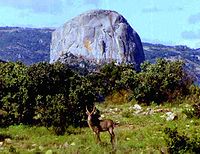 A wildlife checklist compiled over several years reveals a remarkable diversity of mammals, including occasional sightings of species such as buffalo
A wildlife checklist compiled over several years reveals a remarkable diversity of mammals, including occasional sightings of species such as buffalo
and lion
that stray into the region from the Mozambique lowlands. Visitors are likely to see kudu
, reedbuck
, klipspringer
and several other antelope
; predators, including leopard
and hyaena
, are also present. The African clawless otter
is common in the upper Kairezi River, in the north-east of the park.
The park is best known among wildlife conservationists for its populations of blue duiker
and samango monkey
s. Neither animal is found outside the Eastern Highlands. The Inyangani River Frog
is an endangered amphibian found in rocky, fast-flowing streams in the montane grassland.
Lake Gulliver and the Mare, Udu, Purdon and Rhodes Dams have been stocked with trout
from hatcheries maintained by the Department of National Parks. The rainbow trout
is most widespread within the park's dams and streams but brown trout
and American brook trout
are also present.
Geography
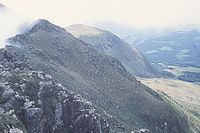 The park is dominated by Mount Nyangani
The park is dominated by Mount Nyangani
which lies in the centre and is the highest mountain in Zimbabwe.
The park is well watered by numerous streams and rivers. The central and eastern parts of the park form part of the Zambezi Basin. The Nyangombe River, whose tributaries include the Mare River and the Nyamuziwa River, and the Kayirezi River both flow north out of the park, ultimately to join the Mazowe River
. The Pungwe River
rises at the foot of Nyangani and flows southwards through the park before dropping 787 feet (239.9 m) into the densely wooded Pungwe Gorge. The Mutarazi Falls
, a few kilometres south of the Pungwe Gorge, have a 2499 feet (761.7 m) drop and are Zimbabwe's highest waterfall; they drop in two stages over granite cliffs into the Honde River
valley, which lies outside the park and is a major tea-planting area.
Five dams have been constructed for recreation and tourist water supply: Rhodes Dam and Mare Dam on the Mare River, Lake Gulliver and Purdon Dams on tributaries of the Mare River and Udu Dam on a tributary of the Nyangombe River.
Most of Nyanga National Park is underlain by granite
. The highest mountains are composed of Umkondo Group dolerite and sandstone
, with the harder dolerite forming cliffs and ridges and the granite-dolerite contact often forming waterfalls. The Troutbeck dolerite sill, shown in the distance in the photograph of Kwaraguza above, was dated
at 1099 Ma.
Archaeological
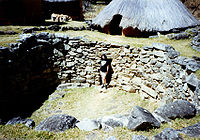 Fifteenth to seventeenth century ruins of the Ziwa
Fifteenth to seventeenth century ruins of the Ziwa
people (upland culture) have been found throughout Nyanga. The ruins include homesteads, centred around pit structures thought to have been used as cattle-pens and larger hill-top settlements, referred to as Forts. The pit structures were once referred to as slave pits, but that interpretation has generally been not supported by archaeologists and is now discredited. There are three sites which can be readily accessed by tourists: Chawomera Fort is located above the Nyangombe River, on a gravel road north of the park headquarters. In addition to the fort, there are several pit structures. Nyangwe Fort, near Mare Dam, is the most extensive and best-preserved ruin in the park. It is a top a small hill with good views over the Mare valley. Near the park headquarters is a reconstructed pit structure - the homestead around a pit structure has been rebuilt and a site museum established. Several other sites have spectacular locations, such as the fort which overlooks the confluence of the Nyangombe and Nyaumziwa rivers and a small fort on top of a hill just west of Mount Nyangani. However these two sites are not easily accessible.
Associated with the ruins are extensive agricultural terracing and irrigation furrows. Iron extraction was practised, mainly to support the complex agricultural technology.
The core areas of the park were once the private estate of Cecil Rhodes. He acquired it with the aim of growing apples and raising sheep, and spent the last years of his life at his homestead near Rhodes Dam. This homestead is now the Rhodes Museum and Rhodes Nyanga Hotel.
There are also two lodges at the Pungwe Drift (currently leased to a private operator), one located on each side a ford
over the Pungwe River
, upstream of the Pungwe Falls. There used to be an isolated chalet at Nyamuziwa Falls, but this was closed in the 1970s.
. The larger Nyangombe camping ground, on the main highway from Mutare
to Nyanga town
was closed in the late 1990s.
.
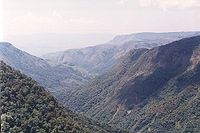
to Mutare
highway. The Pungwe Drift substation and lodges are at the end of a steep dust road, off the Secenic Road. The Pungwe View, from which the Pungwe Falls and Pungwe Gorge can be seen, is on the edge of the Scenic Road. Further south is Mutarazi Falls
- the highest waterfall in Zimbabwe, which can also be accessed by most vehicles.
Access to the beautiful Thomberutedza Falls requires four wheel drive and the dense Pungwe gorge rainforest can only be accessed on foot. There is a four wheel drive track that links the Pungwe Drift to Mount Nyangani, through the Nyazengu area.
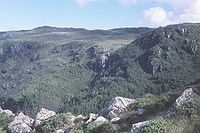 The land east of Mount Nyangani was added to the park in the late 1990s and is administered from the Donjera (Gleneagles) Substation on the former Inyanga Block Estate. The area comprises the eastern slopes of Mount Nyangani, Little Nyangani and Mataka Mountains and the Kayirezi and Nyama valleys. Much of the lower-lying ground is forested with pine
The land east of Mount Nyangani was added to the park in the late 1990s and is administered from the Donjera (Gleneagles) Substation on the former Inyanga Block Estate. The area comprises the eastern slopes of Mount Nyangani, Little Nyangani and Mataka Mountains and the Kayirezi and Nyama valleys. Much of the lower-lying ground is forested with pine
and blue gum
.
Access by road is from Mount Nyangani along the Gleneagles road or from Troutbeck
via Nyafaru. This requires special permission from park headquarters, as the roads are gated.
and Rusape
to Nyanga village
. The main road to Nyanga town passes through the park shortly after Juliasdale
.
Hiking
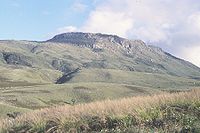 There are numerous hiking paths leading to most of the waterfalls and many of the ruins, and along the rivers and mountains in the park. The scenic beauty of many of the roads and tracks also makes these attractive for hiking.
There are numerous hiking paths leading to most of the waterfalls and many of the ruins, and along the rivers and mountains in the park. The scenic beauty of many of the roads and tracks also makes these attractive for hiking.
The main route up Mount Nyangani is an exhilarating hike and offers spectacular views across the park, much of Nyanga District and further into Mozambique
.
Horse riding
Short horse-riding trails are available around Nyangwe Fort, the Experimental Fruit Station and Mare Dam, as well as longer trails into Warrendale, beyond Udu Dam. The trails start and end at the Pony Trails office, on the gravel road from the park headquarters to Mare Dam.
Fly fishing
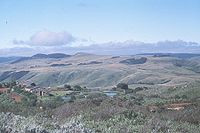 The five dams and the Kayirezi, Mare, Nyamuziwa, Nyangombe and Pungwe Rivers are stocked with rainbow trout
The five dams and the Kayirezi, Mare, Nyamuziwa, Nyangombe and Pungwe Rivers are stocked with rainbow trout
. Brown trout
and brook trout
are to be found in Lake Gulliver and Purdon Dam only. The park entrance fee includes a fishing license, valid for all waters open to fishing, except for Lake Gulliver and Purdon Dam, for which a separate license is available. Fishing is restricted to certain times of year.
Boating
The park's five dams are all suitable for boating and boats are available for hire at Rhodes, Mare and Udu Dams.
Zimbabwe
Zimbabwe is a landlocked country located in the southern part of the African continent, between the Zambezi and Limpopo rivers. It is bordered by South Africa to the south, Botswana to the southwest, Zambia and a tip of Namibia to the northwest and Mozambique to the east. Zimbabwe has three...
's Eastern Highlands
Eastern Highlands
The Eastern or 'East African Highlands is a mountain range in the east of Zimbabwe and one of 4 distinct physiographic divisions on the African continent.-Location and description:...
. One of the first national park
National park
A national park is a reserve of natural, semi-natural, or developed land that a sovereign state declares or owns. Although individual nations designate their own national parks differently A national park is a reserve of natural, semi-natural, or developed land that a sovereign state declares or...
s to be declared in the country, it contains the highest land in Zimbabwe, with green hills and perennial rivers. Most of its terrain consists of rolling downland, sometimes lightly wooded, lying at altitudes between 1,800–2,593 metres (6,560–7,544 feet). Mount Nyangani
Mount Nyangani
Mount Nyangani is the highest mountain in Zimbabwe at 2,592 m . The mountain is located within Nyanga National Park in Nyanga District, is about south east of Harare. The summit lies atop a small outcrop of rock around 40m above the surrounding area...
, the highest point in Zimbabwe, lies in the centre of the park and Mutarazi Falls
Mutarazi Falls
Mutarazi Falls is a 762 m free-leaping waterfall of two delicate tiers, in the Honde Valley in the Eastern Highlands of Zimbabwe. The falls occur at a point where the Mtarazi river flows over the edge of the eastern escarpment of Zimbabwe's highlands.The waterfall is the 17th highest in the world...
, Zimbabwe
Zimbabwe
Zimbabwe is a landlocked country located in the southern part of the African continent, between the Zambezi and Limpopo rivers. It is bordered by South Africa to the south, Botswana to the southwest, Zambia and a tip of Namibia to the northwest and Mozambique to the east. Zimbabwe has three...
's highest waterfall, is in the south of the park. Nyanga National park incorporates the former Mutarazi Falls National Park on its southern boundary.
History of the park

The park nearly doubled in size with the late 1990s purchase of most of the Inyanga Block and Kwaraguza farms. These purchases expanded the national park to the north and east of Mount Nyangani, incorporating some important areas of montane rainforest, the source area of the Kayirezi River and Nyama Falls. The designation and acquisition of Nyazengu farm in 2000, previously an enclave within the park, completed the formal protection of Mount Nyangani and the headwaters of the Pungwe River
Pungwe River
Pungwe River is a 400 km long river in Zimbabwe and Mozambique. It rises below Mount Nyangani in the Eastern Highlands of Zimbabwe and then flows eastward through the Manica and Sofala provinces of Mozambique. It then empties to the Mozambique Channel in Beira, forming a large estuary...
, although Nyazengu had previously been operated as a private nature reserve.
The current name Nyanga reflects the correct vernacular pronunciation of the area.
FloraFloraFlora is the plant life occurring in a particular region or time, generally the naturally occurring or indigenous—native plant life. The corresponding term for animals is fauna.-Etymology:...

Montane grasslands and shrublands
Montane grasslands and shrublands is a biome defined by the World Wildlife Fund. The biome includes high altitude grasslands and shrublands around the world....
ecoregion
Ecoregion
An ecoregion , sometimes called a bioregion, is an ecologically and geographically defined area that is smaller than an ecozone and larger than an ecosystem. Ecoregions cover relatively large areas of land or water, and contain characteristic, geographically distinct assemblages of natural...
. The rainforest is found mainly on the eastern (leeward) slopes, as well as in the steeper valleys on west-facing slopes. It is dominated by Syzygium
Syzygium
Syzygium is a genus of flowering plants that belongs to the myrtle family, Myrtaceae. The genus comprises about 1100 species, and has a native range that extends from Africa and Madagascar through southern Asia east through the Pacific...
Woodlands of dwarf msasa have developed on some westward-facing slopes. Copses of Mulanje cypress
Widdringtonia whytei
Widdringtonia whytei is a species of Widdringtonia native to Malawi, where it is endemic to the Mulanje Massif at altitudes of 1,830-2,550 m. It has become endangered as a result of over-harvesting for its wood, and an increase in the frequency of wildfires due to human activity.It is a large...
survive in areas that are safe from fire.
Treeferns are a very noticeable part of the Nyanga flora, with the common tree fern
Cyathea dregei
Cyathea dregei, also known as the Common Tree Fern and Gewone Boomvaring in Afrikaans, is a widespread species of tree fern in southern Africa...
occurring on the moorlands and the forest tree fern
Cyathea capensis
Cyathea capensis, also known as the Forest Tree Fern, is a widespread and highly variable species of tree fern. It is divided into two subspecies: C. c. capensis from the Old World Tropics and C. c. polypodioides from the New World Tropics. It is the only member of the family Cyatheaceae found in...
in the rainforests. The Nyanga aloe, Aloe inyangensis
Aloe inyangensis
Aloe inyangensis is a succulent aloe plant species, found only in the mountainous Eastern Highlands of Zimbabwe. It grows best in shady conditions but in some areas is also found in the open in heaths on mountain tops. There are two subspecies: the relatively flimsy A. inyangensis inyangensis...
, is found on higher ground.
Black wattle, introduced into plantations outside the park spread rapidly into several parts of the park. Pine
Pine
Pines are trees in the genus Pinus ,in the family Pinaceae. They make up the monotypic subfamily Pinoideae. There are about 115 species of pine, although different authorities accept between 105 and 125 species.-Etymology:...
, planted between Rhodes and Mare Dams, also spread. By 1988 it was estimated that around 40 % of the park had been invaded by these alien species. The park authorities maintain a continuous eradication programme.
FaunaFaunaFauna or faunæ is all of the animal life of any particular region or time. The corresponding term for plants is flora.Zoologists and paleontologists use fauna to refer to a typical collection of animals found in a specific time or place, e.g. the "Sonoran Desert fauna" or the "Burgess shale fauna"...

African Buffalo
The African buffalo, affalo, nyati, Mbogo or Cape buffalo is a large African bovine. It is not closely related to the slightly larger wild Asian water buffalo, but its ancestry remains unclear...
and lion
Lion
The lion is one of the four big cats in the genus Panthera, and a member of the family Felidae. With some males exceeding 250 kg in weight, it is the second-largest living cat after the tiger...
that stray into the region from the Mozambique lowlands. Visitors are likely to see kudu
Kudu
The kudus are two species of antelope of the genus Tragelaphus:*Lesser Kudu, Tragelaphus imberbis*Greater Kudu, Tragelaphus strepsiceros- Etymology :...
, reedbuck
Reedbuck
Reedbuck is a common name for African antelopes from the genus Redunca. These species are:* Southern Reedbuck, Redunca arundinum* Mountain Reedbuck, Redunca fulvorufula* Bohor Reedbuck, Redunca redunca...
, klipspringer
Klipspringer
The Klipspringer, Oreotragus oreotragus, is a small species of African antelope.-Name:The word klipspringer literally means "rock jumper" in Afrikaans/Dutch...
and several other antelope
Antelope
Antelope is a term referring to many even-toed ungulate species indigenous to various regions in Africa and Eurasia. Antelopes comprise a miscellaneous group within the family Bovidae, encompassing those old-world species that are neither cattle, sheep, buffalo, bison, nor goats...
; predators, including leopard
Leopard
The leopard , Panthera pardus, is a member of the Felidae family and the smallest of the four "big cats" in the genus Panthera, the other three being the tiger, lion, and jaguar. The leopard was once distributed across eastern and southern Asia and Africa, from Siberia to South Africa, but its...
and hyaena
Hyaena
For the Siouxsie and the Banshees album, see Hyæna.For the group of animals commonly known as "hyaena", see Hyena.Hyaena is a genus comprising two of the living species of hyenas: the striped hyena from western Asia and northern Africa and the brown hyena from southern Africa...
, are also present. The African clawless otter
African Clawless Otter
The African clawless otter , also known as the cape clawless otter or groot otter, is the second largest freshwater species of otter. African clawless otters are found near permanent bodies of water in savannah and lowland forest areas...
is common in the upper Kairezi River, in the north-east of the park.
The park is best known among wildlife conservationists for its populations of blue duiker
Blue Duiker
Blue Duiker is a small forest dwelling duiker found in the Central Africa and southern South Africa.Blue Duikers stand around 35 centimetres tall at the shoulder and weigh 4 kilograms.They are the smallest of the antelope family. Blue Duikers have a brown coat with a slight blue tinge – hence...
and samango monkey
Sykes' Monkey
Sykes' monkey , also known as the white-throated monkey or Samango monkey, is an Old World monkey found between Ethiopia and South Africa, including south and east Democratic Republic of Congo...
s. Neither animal is found outside the Eastern Highlands. The Inyangani River Frog
Inyangani River Frog
The Inyangani River Frog is a species of frog in the Ranidae family.It is found in Zimbabwe and possibly Mozambique.Its natural habitats are subtropical or tropical high-altitude grassland and rivers....
is an endangered amphibian found in rocky, fast-flowing streams in the montane grassland.
Lake Gulliver and the Mare, Udu, Purdon and Rhodes Dams have been stocked with trout
Trout
Trout is the name for a number of species of freshwater and saltwater fish belonging to the Salmoninae subfamily of the family Salmonidae. Salmon belong to the same family as trout. Most salmon species spend almost all their lives in salt water...
from hatcheries maintained by the Department of National Parks. The rainbow trout
Rainbow trout
The rainbow trout is a species of salmonid native to tributaries of the Pacific Ocean in Asia and North America. The steelhead is a sea run rainbow trout usually returning to freshwater to spawn after 2 to 3 years at sea. In other words, rainbow trout and steelhead trout are the same species....
is most widespread within the park's dams and streams but brown trout
Brown trout
The brown trout and the sea trout are fish of the same species....
and American brook trout
Brook trout
The brook trout, Salvelinus fontinalis, is a species of fish in the salmon family of order Salmoniformes. In many parts of its range, it is known as the speckled trout or squaretail. A potamodromous population in Lake Superior are known as coaster trout or, simply, as coasters...
are also present.
GeographyGeographyGeography is the science that studies the lands, features, inhabitants, and phenomena of Earth. A literal translation would be "to describe or write about the Earth". The first person to use the word "geography" was Eratosthenes...
and geologyGeologyGeology is the science comprising the study of solid Earth, the rocks of which it is composed, and the processes by which it evolves. Geology gives insight into the history of the Earth, as it provides the primary evidence for plate tectonics, the evolutionary history of life, and past climates...

Mount Nyangani
Mount Nyangani is the highest mountain in Zimbabwe at 2,592 m . The mountain is located within Nyanga National Park in Nyanga District, is about south east of Harare. The summit lies atop a small outcrop of rock around 40m above the surrounding area...
which lies in the centre and is the highest mountain in Zimbabwe.
The park is well watered by numerous streams and rivers. The central and eastern parts of the park form part of the Zambezi Basin. The Nyangombe River, whose tributaries include the Mare River and the Nyamuziwa River, and the Kayirezi River both flow north out of the park, ultimately to join the Mazowe River
Mazowe River
The Mazowe River is a river in Zimbabwe and Mozambique.The river rises north of Harare, flows north and then northeast, where it forms part of the border with Mozambique, before entering the Zambezi River...
. The Pungwe River
Pungwe River
Pungwe River is a 400 km long river in Zimbabwe and Mozambique. It rises below Mount Nyangani in the Eastern Highlands of Zimbabwe and then flows eastward through the Manica and Sofala provinces of Mozambique. It then empties to the Mozambique Channel in Beira, forming a large estuary...
rises at the foot of Nyangani and flows southwards through the park before dropping 787 feet (239.9 m) into the densely wooded Pungwe Gorge. The Mutarazi Falls
Mutarazi Falls
Mutarazi Falls is a 762 m free-leaping waterfall of two delicate tiers, in the Honde Valley in the Eastern Highlands of Zimbabwe. The falls occur at a point where the Mtarazi river flows over the edge of the eastern escarpment of Zimbabwe's highlands.The waterfall is the 17th highest in the world...
, a few kilometres south of the Pungwe Gorge, have a 2499 feet (761.7 m) drop and are Zimbabwe's highest waterfall; they drop in two stages over granite cliffs into the Honde River
Honde River
Honde River pronounced Horn-de is a river in Eastern Highlands of Zimbabwe which runs through the Honde Valley. It flows from Mount Inyangani on the western edges of Honde Valley were it is joined by several of its major tributaries: the rivers Mupenga, Buu, Mtarazi and Ngarura...
valley, which lies outside the park and is a major tea-planting area.
Five dams have been constructed for recreation and tourist water supply: Rhodes Dam and Mare Dam on the Mare River, Lake Gulliver and Purdon Dams on tributaries of the Mare River and Udu Dam on a tributary of the Nyangombe River.
Most of Nyanga National Park is underlain by granite
Granite
Granite is a common and widely occurring type of intrusive, felsic, igneous rock. Granite usually has a medium- to coarse-grained texture. Occasionally some individual crystals are larger than the groundmass, in which case the texture is known as porphyritic. A granitic rock with a porphyritic...
. The highest mountains are composed of Umkondo Group dolerite and sandstone
Sandstone
Sandstone is a sedimentary rock composed mainly of sand-sized minerals or rock grains.Most sandstone is composed of quartz and/or feldspar because these are the most common minerals in the Earth's crust. Like sand, sandstone may be any colour, but the most common colours are tan, brown, yellow,...
, with the harder dolerite forming cliffs and ridges and the granite-dolerite contact often forming waterfalls. The Troutbeck dolerite sill, shown in the distance in the photograph of Kwaraguza above, was dated
Radiometric dating
Radiometric dating is a technique used to date materials such as rocks, usually based on a comparison between the observed abundance of a naturally occurring radioactive isotope and its decay products, using known decay rates...
at 1099 Ma.
ArchaeologicalArchaeologyArchaeology, or archeology , is the study of human society, primarily through the recovery and analysis of the material culture and environmental data that they have left behind, which includes artifacts, architecture, biofacts and cultural landscapes...
, historicalHistoryHistory is the discovery, collection, organization, and presentation of information about past events. History can also mean the period of time after writing was invented. Scholars who write about history are called historians...
and culturalCultureCulture is a term that has many different inter-related meanings. For example, in 1952, Alfred Kroeber and Clyde Kluckhohn compiled a list of 164 definitions of "culture" in Culture: A Critical Review of Concepts and Definitions...
sites

Ziwa
Ziwa, or Ziwa ruins is the name used to describe the remains of a vast late Iron Age agricultural settlement that has been dated to the 17th century. The site is located in Nyanga, Zimbabwe. Ziwa was declared a National Monument in 1946 and is currently under consideration for World Heritage listing...
people (upland culture) have been found throughout Nyanga. The ruins include homesteads, centred around pit structures thought to have been used as cattle-pens and larger hill-top settlements, referred to as Forts. The pit structures were once referred to as slave pits, but that interpretation has generally been not supported by archaeologists and is now discredited. There are three sites which can be readily accessed by tourists: Chawomera Fort is located above the Nyangombe River, on a gravel road north of the park headquarters. In addition to the fort, there are several pit structures. Nyangwe Fort, near Mare Dam, is the most extensive and best-preserved ruin in the park. It is a top a small hill with good views over the Mare valley. Near the park headquarters is a reconstructed pit structure - the homestead around a pit structure has been rebuilt and a site museum established. Several other sites have spectacular locations, such as the fort which overlooks the confluence of the Nyangombe and Nyaumziwa rivers and a small fort on top of a hill just west of Mount Nyangani. However these two sites are not easily accessible.
Associated with the ruins are extensive agricultural terracing and irrigation furrows. Iron extraction was practised, mainly to support the complex agricultural technology.
The core areas of the park were once the private estate of Cecil Rhodes. He acquired it with the aim of growing apples and raising sheep, and spent the last years of his life at his homestead near Rhodes Dam. This homestead is now the Rhodes Museum and Rhodes Nyanga Hotel.
Rest camps
There are three large rest camps in Nyanga National Park, all of which consist of fully equipped, self-catering lodges. Rhodes Dam, which is also the park headquarters, is located near the main entrance in a pine forest. Mare Dam (currently closed pending refurbishment) is some eight kilometers east of Rhodes, in the center of the park and close to Nyangwe Fort. Udu Dam is in the north-west of the park, on the road to Nyangombe Falls.There are also two lodges at the Pungwe Drift (currently leased to a private operator), one located on each side a ford
Ford (crossing)
A ford is a shallow place with good footing where a river or stream may be crossed by wading or in a vehicle. A ford is mostly a natural phenomenon, in contrast to a low water crossing, which is an artificial bridge that allows crossing a river or stream when water is low.The names of many towns...
over the Pungwe River
Pungwe River
Pungwe River is a 400 km long river in Zimbabwe and Mozambique. It rises below Mount Nyangani in the Eastern Highlands of Zimbabwe and then flows eastward through the Manica and Sofala provinces of Mozambique. It then empties to the Mozambique Channel in Beira, forming a large estuary...
, upstream of the Pungwe Falls. There used to be an isolated chalet at Nyamuziwa Falls, but this was closed in the 1970s.
Camping sites
There is also a camping ground and caravan park on the Mare River half a kilometer west of Rhodes Dam, and a second camping ground at Mutarazi FallsMutarazi Falls
Mutarazi Falls is a 762 m free-leaping waterfall of two delicate tiers, in the Honde Valley in the Eastern Highlands of Zimbabwe. The falls occur at a point where the Mtarazi river flows over the edge of the eastern escarpment of Zimbabwe's highlands.The waterfall is the 17th highest in the world...
. The larger Nyangombe camping ground, on the main highway from Mutare
Mutare
Mutare is the fourth largest city in Zimbabwe, with a population of around 170,000. It is the capital of Manicaland province.-History:...
to Nyanga town
Nyanga
Nyanga may mean:*Nyanga Province, of Gabon*Nyanga, Gabon, a place in the province of Nyanga in Gabon*Nyanga River, in Gabon and Congo*Nyanga, Zimbabwe, a town*Nyanga National Park in Zimbabwe*Nyanga, Cape Town, a township in South Africa...
was closed in the late 1990s.
Privately owned camps and sites
There are two private facilities within the park: Rhodes Hotel, on the south bank of Rhodes Dam, incorporating Cecil Rhodes' old homestead, and the Mountain Club of Zimbabwe hut, on the Kwaraguza road from Mount Nyangani to TroutbeckTroutbeck, Manicaland
Troutbeck is a village in the province of Manicaland, Zimbabwe located in the Eastern Highlands on the northern border of Nyanga National Park and situated on a highland plateau at an altitude of about 2100m.-Tourism:...
.
Central and western area
This is the most developed part of the park, stretching from the park headquarters at Rhodes Dam to Mount Nyangani. The area includes the three rest camps and the five dams. Places of interest which are accessible on dust roads maintained by the park are Nyangombe Falls, Nyamuziwa Falls, Mount Nyangani and the two largest archaeological sites: Nyangwe Fort and Chawomera Fort. This area also includes the main recreational facilities, such as the five dams stocked for fly-fishing and the pony trails office.
Southern area
Administered from the Pungwe Drift substation, this region is less developed, with roads only along the edges. Access from the park headquarters is via the "Scenic road", a gravel road that runs parallel to the NyangaNyanga, Zimbabwe
Nyanga is a town in the province of Manicaland, Zimbabwe, located adjacent to Nyanga National Park in the Eastern Highlands about 105 km north of Mutare. According to the 1982 Population Census, the town had a population of 2,973....
to Mutare
Mutare
Mutare is the fourth largest city in Zimbabwe, with a population of around 170,000. It is the capital of Manicaland province.-History:...
highway. The Pungwe Drift substation and lodges are at the end of a steep dust road, off the Secenic Road. The Pungwe View, from which the Pungwe Falls and Pungwe Gorge can be seen, is on the edge of the Scenic Road. Further south is Mutarazi Falls
Mutarazi Falls
Mutarazi Falls is a 762 m free-leaping waterfall of two delicate tiers, in the Honde Valley in the Eastern Highlands of Zimbabwe. The falls occur at a point where the Mtarazi river flows over the edge of the eastern escarpment of Zimbabwe's highlands.The waterfall is the 17th highest in the world...
- the highest waterfall in Zimbabwe, which can also be accessed by most vehicles.
Access to the beautiful Thomberutedza Falls requires four wheel drive and the dense Pungwe gorge rainforest can only be accessed on foot. There is a four wheel drive track that links the Pungwe Drift to Mount Nyangani, through the Nyazengu area.
Eastern area

Pine
Pines are trees in the genus Pinus ,in the family Pinaceae. They make up the monotypic subfamily Pinoideae. There are about 115 species of pine, although different authorities accept between 105 and 125 species.-Etymology:...
and blue gum
Blue Gum
Blue Gum usually refers to the subspecies or the species in Eucalyptus globulus complex, however it may also refer to a number of other species of Eucalyptus in Australia. Confusingly, in Queensland it usually refers to Eucalyptus tereticornis, which is known elsewhere as Forest Red Gum.* Gippsland...
.
Access by road is from Mount Nyangani along the Gleneagles road or from Troutbeck
Troutbeck, Manicaland
Troutbeck is a village in the province of Manicaland, Zimbabwe located in the Eastern Highlands on the northern border of Nyanga National Park and situated on a highland plateau at an altitude of about 2100m.-Tourism:...
via Nyafaru. This requires special permission from park headquarters, as the roads are gated.
Access
There are tarred roads from MutareMutare
Mutare is the fourth largest city in Zimbabwe, with a population of around 170,000. It is the capital of Manicaland province.-History:...
and Rusape
Rusape
Rusape is a town in the province of Manicaland, Zimbabwe with a population of around 20,000 , situated on the Harare-Mutare main road, approximately 170 km south east of Harare and 93 km north west of Mutare. Rusape is a large, sprawling town that has not quite reached city status...
to Nyanga village
Nyanga, Zimbabwe
Nyanga is a town in the province of Manicaland, Zimbabwe, located adjacent to Nyanga National Park in the Eastern Highlands about 105 km north of Mutare. According to the 1982 Population Census, the town had a population of 2,973....
. The main road to Nyanga town passes through the park shortly after Juliasdale
Juliasdale
Juliasdale is a town in the province of Manicaland, Zimbabwe located in the Eastern Highlands about 23 km south of Nyanga. Forestry and fruit are farmed in the region. While it is home to the first Casino in the country, the mountainous town is an attractive destination for tourism....
.
Game viewing
Although there are no game viewing hides and Nyanga is not primarily a game park, there is a variety of wildlife to be seen, especially in the central and western parts of the park.HikingHikingHiking is an outdoor activity which consists of walking in natural environments, often in mountainous or other scenic terrain. People often hike on hiking trails. It is such a popular activity that there are numerous hiking organizations worldwide. The health benefits of different types of hiking...

The main route up Mount Nyangani is an exhilarating hike and offers spectacular views across the park, much of Nyanga District and further into Mozambique
Mozambique
Mozambique, officially the Republic of Mozambique , is a country in southeastern Africa bordered by the Indian Ocean to the east, Tanzania to the north, Malawi and Zambia to the northwest, Zimbabwe to the west and Swaziland and South Africa to the southwest...
.
Horse ridingTrail ridingTrail riding sometimes called horse or pony trekking is riding outdoors on natural trails and roads as opposed to riding in an enclosed area such as a riding arena. The term may encompass those who travel on horses, on mountain bikes, or on motorcycles and other motorized all-terrain vehicles...
Short horse-riding trails are available around Nyangwe Fort, the Experimental Fruit Station and Mare Dam, as well as longer trails into Warrendale, beyond Udu Dam. The trails start and end at the Pony Trails office, on the gravel road from the park headquarters to Mare Dam.Fly fishingFly fishingFly fishing is an angling method in which an artificial 'fly' is used to catch fish. The fly is cast using a fly rod, reel, and specialized weighted line. Casting a nearly weightless fly or 'lure' requires casting techniques significantly different from other forms of casting...

Rainbow trout
The rainbow trout is a species of salmonid native to tributaries of the Pacific Ocean in Asia and North America. The steelhead is a sea run rainbow trout usually returning to freshwater to spawn after 2 to 3 years at sea. In other words, rainbow trout and steelhead trout are the same species....
. Brown trout
Brown trout
The brown trout and the sea trout are fish of the same species....
and brook trout
Brook trout
The brook trout, Salvelinus fontinalis, is a species of fish in the salmon family of order Salmoniformes. In many parts of its range, it is known as the speckled trout or squaretail. A potamodromous population in Lake Superior are known as coaster trout or, simply, as coasters...
are to be found in Lake Gulliver and Purdon Dam only. The park entrance fee includes a fishing license, valid for all waters open to fishing, except for Lake Gulliver and Purdon Dam, for which a separate license is available. Fishing is restricted to certain times of year.
Swimming
River in the park are free of bilharzia, unlike the rest of Zimbabwe. There is a natural swimming pool on the Nyangombe River, near the park headquarters, and a swimming weir on the Udu River below Udu Dam.BoatingBoatingBoating is the leisurely activity of travelling by boat, or the recreational use of a boat whether powerboats, sailboats, or man-powered vessels , focused on the travel itself, as well as sports activities, such as fishing or water skiing...
The park's five dams are all suitable for boating and boats are available for hire at Rhodes, Mare and Udu Dams.See also
- Mutarazi FallsMutarazi FallsMutarazi Falls is a 762 m free-leaping waterfall of two delicate tiers, in the Honde Valley in the Eastern Highlands of Zimbabwe. The falls occur at a point where the Mtarazi river flows over the edge of the eastern escarpment of Zimbabwe's highlands.The waterfall is the 17th highest in the world...
- Nyanga villageNyanga, ZimbabweNyanga is a town in the province of Manicaland, Zimbabwe, located adjacent to Nyanga National Park in the Eastern Highlands about 105 km north of Mutare. According to the 1982 Population Census, the town had a population of 2,973....
- Mount NyanganiMount NyanganiMount Nyangani is the highest mountain in Zimbabwe at 2,592 m . The mountain is located within Nyanga National Park in Nyanga District, is about south east of Harare. The summit lies atop a small outcrop of rock around 40m above the surrounding area...

